| |
|
Previous: First Flight |
|
| |
|
02/4/2006 - First Cross Country - 2.2 hours
Today I decided that it's time to leave the confines of the airport and let the engine run for a while. I understand that the first 10 hours of a new engine is critical to seating the rings in the new cylinders, and they recommend running it hard. That's difficult to do when you're flying circles around an airport. Everything has been working so well that I was confident that I could fly 50 miles for breakfast. |
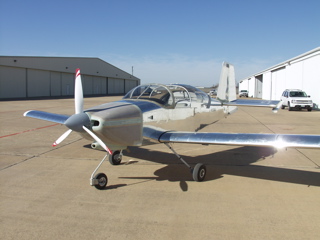 |
| |
|
My friend, Todd Agold, and I met at the airport this Saturday to do some flying. This is Todd's Sonex. I've posted pictures of his plane before, but this is the first time we've been able to fly someplace together. Todd still has 20 hours of test flying left to do, so it's great that we can fly together occasionally.
Okay, so now about the flight. The first destination was Sulphur Springs. There's a little restaurant there that we stopped at for breakfast. |
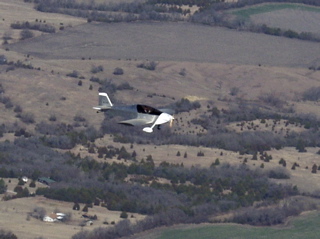 |
| |
|
The plane performed really well. I had made some adjustments to the egt sensor wires to see if it would fix the problem. No joy. I still have a seismograph for EGT#2.
Next, I activated the autopilot for the first time. As soon as I did the plane began a gentle bank to the right. Not good. So, I disengaged the autopilot and flew the remainder of the flight without it.
On the next flight I decided to put it in course mode and try it again. This time it worked great. It held course even in turbulent air. |
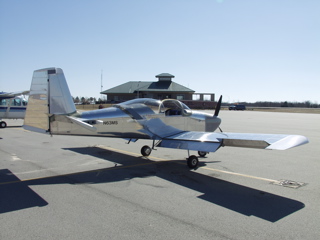 |
| |
|
So I think there must be a calibration that I missed for the autopilot. I'll sort that out later.
The second flight was about an hour long and really gave me a chance to get a feel for the airplane in flight. |
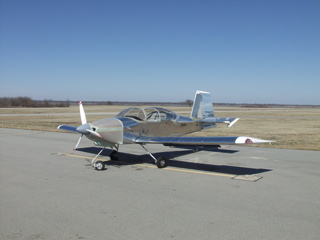 |
| |
|
The second stop of the day was at Sherman to get gas. As I was turning base I got a call on the radio from another builder, Tom Moore, who flies an RV-7A. I hadn't spoken to him since I've been flying. The next thing we know, just about the whole EAA chapter lands at Sherman for fuel. Apparently they had an informal fly-out for lunch and we just happened to catch them as they returned from Oklahoma.
So I've got a few things to work on, but overall the plane flies wonderfully. |
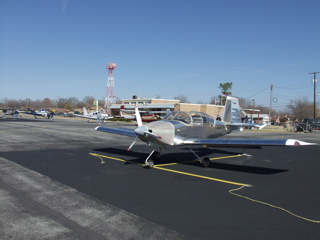 |
| |
|
2/8/06 - Longer Flight - 2.1 hours
Today I started by trying to solve the EGT sensor issue by putting new connectors on the wire. It didn't work, but at least I tried. I think I'm going to order a replacement sensor and see if that fixes it.
Next, I went out to the compass rose and tried to calibrate the magnetometer. It seems to be more accurate now, but I may do it again just to be safe.
I took off and headed east. I flew 80 miles to Mt. Pleasant. I didn't land there because I just wanted to let the engine run, so I just turned and headed from there to Sherman to get gas. I was able to use the autopilot on this trip, and it worked like a charm. It correctly flew the GPS flight plan, both from the 396 as well as from the GRT EFIS. It was fun changing the destination airport and watching the autopilot intercept the new heading. |
| |
|
When I returned to the hangar I pulled the cowl off to check things out. I was surprised to find that one of the fancy eyeball firewall penetration grommets had vibrated loose. The ring was held by the cable, but the ball insert had fallen out of place. Amazingly, one half was caught by the gear weldment, but the other half is gone forever. There's no way to safety wire this thing, so I think I may put some Threadlocker on the threads before I reassemble it (with new parts that I have to buy.) |
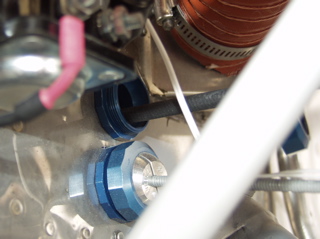 |
| |
|
2/9/06 - Flight to Hicks - 1.3 hours
I flew over to Hicks (T67) today to buy some stuff from Avery Tools. Hicks is on the other side of the DFW Class B airspace, so I had to fly around the north side to reach it. The weather wasn't very airplane friendly. It was bumpy and very hazy. I'd say the visibility was no more than about five miles. I had to fly at or below 2500 feet to stay under the 3000 foot layer of Class B. I also had to fly around the various airports along the way. This is a busy airspace and there is lots of traffic. I radioed Denton and got permission to transition their airspace. I also radioed Alliance for the same clearance. The controllers were helpful in giving me traffic advisories.
Hicks is a tiny airport with about a million hangars. Avery has recently moved to a new facility, so I was wondering how I was going to find it. About the only thing I knew was the hangar number. Fortunately, their new hangar is right on the flight line, so I just taxiied up and shut down.
Avery Tools is one of my all-time favorite aircraft-related companies. They've always taken good care of me. Bob Avery gave me a great tour of the new facilities and showed off his workshop where he machines things like dimple dies and such. He also took the time to check out my airplane. He's a really nice and knowledgeable guy, and I recommend all new builders to spend their money with Avery Tools.
I bought an oil filter cutter and an aircraft spark plug socket. I also got a non-ferrous screwdriver for adjusting the magnetic compass. Finally I asked about the eyeball grommet that had fallen apart yesterday. I was going to just buy another one, but Bob gave me the eyeball parts for nothing. Now I have what I need to fix the grommet.
The trip back was uneventful. In the haze I used my strobes for the first time just so I could be seen a little better. |
| |
|
2/13/06 - Flight to Mt. Pleasant - 2.3 hours
Today I flew a triangular route (TKI-F41-7F5-OSA) to Mt. Pleasant. Along the way I took a short detour to circle my neighborhood so my kids could see the plane in the air. Here's a picture of our neighborhood to confirm that indeed I live in the heart of suburbia. If you look closely you can see the aircraft factory that produced the plane that I'm flying!
|
 |
| |
|
It was a nice clear day. I snapped this picture of downtown Dallas when I was at least 20 miles away. Did I mention the temperature? The OAT said 37 degrees. Chilly. I finally got to try out the cabin heat, which works perfectly, although when the sun is shining there's not much need for cabin heat in the RV.
So at this point I'm still flying south, letting the autopilot do all the work while I scanned for traffic. Before I reached Ennis, which was to be the bottom of my route, I cut the corner and headed northeast. |
 |
| |
|
The GRT EFIS is working great. I'm very pleased by the way this unit performs. It really does more than I need it to do since this is just a VFR aircraft, but it's nice to know that I have the ability to expand if I decide to. The Garmin 396 is excellent as well. I really like this unit. With the weather feature I can see bad weather, but what surprised me is how useful it is to have the METAR and TAF information just a click away. On the map there's a little flag that appears next to any airport with weather data. I can pull this up and see the wind and altimeter readings for that airport. Neat. |
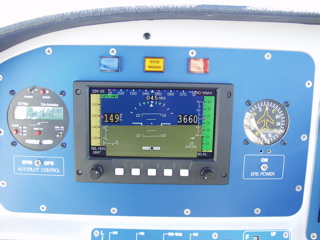 |
| |
|

|
 |
| |
|
Here's Lake Fork in East Texas. By this point I'm starting to watch my fuel more carefully. During this first 10 hours I have been told to run the engine with a full rich mixture. This results in fuel flows of about 10 gph. So, naturally this results in some not-so-good fuel economy. My fuel flow reading was showing that I had 12 gallons left, but as this is all new stuff I really didn't know how much to trust it. So, I decided that Mt. Pleasant would also be a fuel stop for me. |
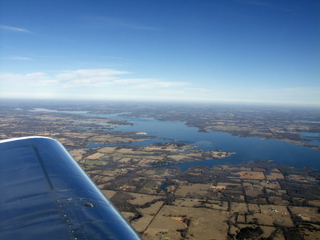 |
| |
|
Mt. Pleasant (OSA) is a really nice, new airport. The people there were really great as well. If you plan to fly in East Texas, stop at Mt. Pleasant. It really is, well, pleasant. They offered me any assistance I might need including a courtesy car. Since I was just stopping for gas I declined. When the folks in the FBO heard that I was flying an RV-9A, they all came outside for a look. There are several RV builders on the field, and they said one of their group was finishing up a -9A. I'm going to have to stop here on a weekend sometime. |
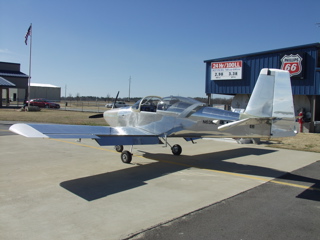 |
| |
|
The trip back to McKinney was bumpy. I flew the return leg at 2500 feet.
So, this trip added 2.3 hours to my flying time, bringing the current total to 8.9 hours. Not too much longer and I'll be doing my first oil change.
Squawks: I'm waiting on a replacement EGT probe from GRT. I have a burned out landing light in the left wing. The magnetic compass needs to be adjusted. Most importantly, I need to work on the gear fairings. |
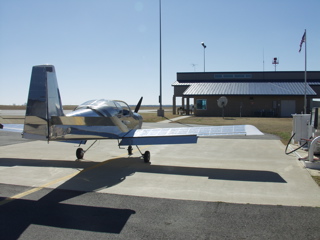 |
| |
|
Next: Installing the landing gear fairings |
|
| |
|

